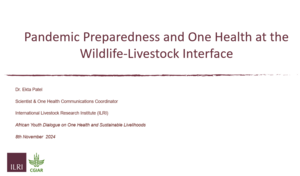
Preliminary efficacy investigations of oral fipronil against Anopheles arabiensis when administered to Zebu cattle (Bos indicus) under field conditions
Abstract
Globally, malaria remains one of the most important vector-borne diseases despite the extensive use of vector control, including indoor residual spraying (IRS) and insecticide-treated nets (ITNs). These control methods target endophagic vectors, whereas some malaria vectors, such as Anopheles arabiensis, preferentially feed outdoors on cattle, making it a complicated vector to control using conventional strategies. Our study evaluated whether treating cattle with a capsule containing the active ingredient (AI) fipronil could reduce vector density and sporozoite rates, and alter blood feeding behavior, when applied in a small-scale field study. A pilot field study was carried out in the Samia District, Western Kenya, from May to July 2015. Four plots, each comprised of 50 huts used for sleeping, were randomly designated to serve as control or treatment. A week before cattle treatment, baseline mosquito collections were performed inside the houses using mechanical aspirators. Animals in the treatment (and buffer) were administered a single oral application of fipronil at ∼0.5 mg/kg of body weight. Indoor mosquito collections were performed once a week for four weeks following treatment. Female mosquitoes were first identified morphologically to species complex, followed by PCR-based methods to obtain species identity, sporozoite presence, and the host source of the blood meal. All three species of anophelines found in the study area (An. gambiae s.s., An. arabiensis, An. funestus s.s.) were actively transmitting Plasmodium falciparumduring the study period. The indoor resting density of An. arabiensis was significantly reduced in treatment plot one at three weeks post-treatment (T1) (efficacy = 89%; T1 density = 0.08, 95% credibility intervals [0.05, 0.10]; control plot density = 0.78 [0.22, 0.29]) and at four weeks post-treatment (efficacy = 64%; T1 density = 0.16 [0.08, 0.14]; control plot density = 0.48 [0.17, 0.22]). The reduction of An. arabiensis mosquitoes captured in the treatment plot two was higher: zero females were collected after treatment. The indoor resting density of An. gambiae s.s. was not significantly different between the treatment (T1, T2) and their corresponding control plots (C1, C2). An. funestus s.s. showed an increase in density over time. The results of this preliminary study suggest that treating cattle orally with fipronil, to target exophagic and zoophagic malaria vectors, could be a valuable control strategy to supplement existing vector control interventions which target endophilic anthropophilic species.
Citation
Poché, R.M., Githaka, N., Gool, F. van, Kading, R.C., Hartman, D., Polyakova, L., Abworo, E.O., Nene, V. and Lozano-Fuentes, S. 2017. Preliminary efficacy investigations of oral fipronil against Anopheles arabiensis when administered to Zebu cattle (Bos indicus) under field conditions. Acta Tropica 176: 126–133.










